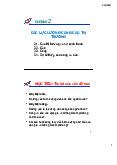




Preview text:
MACROECONOMICS
3. Education in the world
3.1. Developed countries
3.1.1. Educational situation
The quality of education is one of the criteria that has a direct impact on an individual's progress,
a society's civilization, and a country's prosperity. As a result, studying in a country with high-
quality education will undoubtedly provide you with numerous career options, quality study
programs, life-changing opportunities, and global experience...
Europe is the birthplace of many important theories, ideas, and inventions for the rest of the
world. Examples include evolution theory, steam locomotives, three-point seat belts for cars, and
the World Wide Web. Europe also has the most Nobel Prizes, with 470 awarded in the fields of
science, literature, medicine, peace, and physics.
Equal education quality
Education is free and of good quality, and schools have to follow very strict EU regulations to
maintain state funding. There are about 4000 universities in Europe.
Advanced teaching methods
The Council of Europe has promoted a needs-based approach to learners and the use of
appropriate methods. The "reverse classroom model" helps learners develop awareness through
each level: Remember, Understand, Apply, Analyze, Evaluate and Perform. It involves building
knowledge through learning activities organized by teachers in class.
In the traditional teaching-learning model, students passively learn according to the information
that the teacher wants to provide. In the reversed classroom, students actively acquire knowledge
in 2 steps "Remember" and "Understand". Once they "have" knowledge, students come to school
and all class time is spent practicing with teachers and friends.
An open and dynamic educational environment
Classes are held in many different places, such as locations outside schools, and museums. This
helps to create a comfortable atmosphere and interest in learning for students. One of the notable
campaigns of the European Council of Education to promote a safe and open educational
environment is "Speak freely, Learn safely". Top facilities
Most European schools are equipped with spacious campus, equipped with modern teaching and
learning support equipment systems, laboratories, a library, sports field, swimming pool, etc.
Students are exempt from tuition fees completely or only pay a very low fee compared to other
countries. Most European citizens can go to university if they want and graduate without incurring huge tuition debt.
Diverse study program
In order to encourage and welcome international students, many educational institutions in
Europe now use English as the language of instruction for many study programs. Courses taught
in English are distributed across a wide range of disciplines. Not only equipping students with
specialized knowledge but also helping students hone the necessary skills.
3.1.2. Education affects the development
A typical developed economy will include various industries with different competitive
advantages and disadvantages in the global marketplace. The education and training of a
country’s workforce is a major factors in determining how well the country’s economy will perform. For the Economy:
Many countries have prioritized the development of an education system capable of producing
workers capable of functioning in new industries such as science and technology. This is due in
part to older industries in developed economies becoming less competitive and thus less likely
to continue dominating the industrial landscape. A movement to improve the population's basic
education has also emerged, with a growing belief that all people have the right to an education.
As the percentage of educated workers rises, a nation's economy becomes more productive
because educated workers are better able to complete activities that call for reading and critical
thought. A greater degree of knowledge does come with a price, though. A nation may offer
simple literacy initiatives and still see economic growth without having to support a vast network of schools and universities. The bottom line:
The knowledge and skills of workers available in the labor supply are key factors in determining
both business and economic growth. Economies with a significant supply of skilled labor,
brought on through school education as well as training, are often able to capitalize on this
through the development of more value-added industries, such as high-tech manufacturing.
3.1.3. Educational policies
Invest in education in the US:
Investment in education accounts for a significant portion of the US total GDP; nearly every
year, the US spends 5-6% of its total GDP budget on education. huge because not every country
is willing to invest so much money in education Not only that, but the estimated investment in
American education is increasing, demonstrating that Americans care about education and want
to further develop and perfect their education.
Education in the United States is primarily provided by the public, controlled, and the funded
sector at three levels: federal, state, and local. In 2006-2007, the US spent about $553 billion on
primary and secondary education, and it accounted for about 4.2% of the country's total GDP.
Furthermore, the United States has numerous student support programs, such as loan program;
federal loan students will pay a monthly payment equal to 15% of their income, to repay until the
debt is discharged, if the debt has not been paid in full within 25 years, the remaining balance
will be forgiven, implemented in 2014. As a result, the United States has made significant investments in education.
Invest in education in the Japan:
The key to Japan's success in education is the traditional belief that all children can achieve
academic success. Japan strives to leave the responsibility of decision-making on education to
schools. Local governments need to put in place fair policies to attract high-quality teachers to
teach. Many countries appreciate Japan for its clear and ambitious standards in education. The
country has a high-quality teaching and practice system, and effective learning approaches.
Japan is a country with the leading education system in Asia, but the Japanese government does
not spend much on education. Looking at the average ratio of education spending to total
government spending of OECD countries (Organization for Economic Co-operation and
Development) of 12.9%, Japan ranks at the lowest level. second at 9.1%, just behind Italy at 8.6%.
The Japanese government has changed the way the budget is distributed over the ages. More
resources are being channeled to the younger generation. Prime Minister Shinzo Abe's Liberal
Democratic Party is considering introducing a plan to reduce household costs for education.
Students with Australian citizenship can borrow money from the Government to cover tuition
fees during their university years.
The Japanese Government is investing 800 billion yen to subsidize the cost of education from
kindergarten to university for all Japanese. Tuition fees at private universities, two-year colleges,
and vocational schools will also be subsidized from 2020. The investment is part of
PrimeMinister Shinzo Abe's goal to increase Japan's labor productivity by 10% over the next 4 years.
3.2. Developing countries
3.2.1. Educational situation
Developing countries usually do not have an advanced education system.
Children often have to work from an early age.
Poverty-stricken families in developing countries cannot afford to send their children to school.
As a result, children are forced to work in order to support their families.
There are no schools in many areas.
Despite the desire to go to school, there are some areas in India that do not have a nearby school.
These places are usually in the countryside and houses are miles away from each other. Some
children cannot get an apartment because of the distance and the cost of living.
Families do not have access to books or computers.
Because disadvantaged families are struggling to make ends meet, they no longer consider
purchasing a book. As a result, children are deprived of the opportunity to read books or use computers.
Literacy rates are often low.
People in developing countries struggle to read and write due to a lack of schools and teachers.
Aside from that, earning a living is their top priority, not education. As previously stated, people
must arrive at work early. Education is not important to them as long as they are working and earning enough to get by.
(3.2.2 vs 3.2.3 trùng thông tin với 3.1 nhìu lắm) References:
https://www.iemasfinancialservices.co.za/blog/how-education-and-training-affect-the-economy
https://www.outputeducation.com/education-developing-countries-problems-solutions/
https://www.investopedia.com/articles/economics/09/education-training-advantages.asp
https://quocteviet.com/dau-tu-giao-duc-o-mot-so-quoc-gia.html
https://ibid.vn/chat-luong-giao-duc-o-cac-quoc-gia-chau-au-tien-tien-nhu-the-nao/
https://www.dankinhte.vn/chinh-sach-dau-tu-phat-trien-giao-duc-cua-cac-nuoc-tren-gioi/




